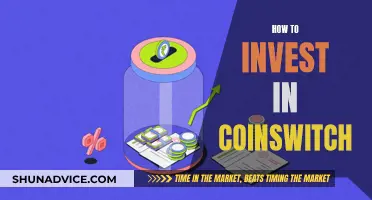
Investing in crypto and buying crypto are two different things. While buying crypto is simply the act of purchasing a digital currency, investing in crypto refers to using it as a vehicle for generating wealth. There are several ways to generate wealth in the crypto market, including mining, investing, and trading. Mining is a technical process that requires setting up sophisticated computing software and equipment. On the other hand, investing and trading are easier ways to make money in the crypto world and do not require the same level of technical knowledge as mining. However, it is important to note that investing and trading come with their own set of risks and challenges.
| Characteristics | Values | |
|---|---|---|
| Investment Period | Long-term | Short-term |
| Trade Frequency | Low | High |
| Risk Profile | Risk-averse | Risk-taker |
| Analysis Type | Fundamental | Technical |
| Profit Methodology | Price Appreciation, Dividends, Hard Forks, Airdrops | Price Appreciation |
What You'll Learn
- Investment Period: Crypto investors are in it for the long haul, ignoring short-term price movements. Crypto traders, on the other hand, focus on short-term price movements and aim to profit from them
- Trade Frequency: Investors have a low trade frequency, whereas traders have a high trade frequency
- Risk Profile: Crypto investors are more risk-averse than traders
- Type of Analysis: Crypto investors focus on fundamental analysis, while traders focus on technical analysis
- Profit Methodology: Crypto investors profit from price appreciation, dividends, hard forks, and airdrops. Traders only focus on price appreciation

Investment Period: Crypto investors are in it for the long haul, ignoring short-term price movements. Crypto traders, on the other hand, focus on short-term price movements and aim to profit from them
Investment Period
Crypto investors and traders have different approaches to generating profits. Crypto investors are focused on the long-term potential of a coin and are not concerned with short-term price movements. They bet on the long-term growth of a coin, intending to sell it for a profit in a few years. This is because blockchain technology is still very new, and it may take a few years or even decades for it to gain mainstream adoption and disrupt traditional systems. On the other hand, crypto traders have a short-term horizon and focus on hourly and daily price movements. They aim to profit from buying coins at a low price and selling them at a higher price in the short term, which can be within minutes, hours, days, or weeks. Volatility is a critical factor for traders as they need sufficient price movements to make a profit. The extreme volatility of the cryptocurrency market makes it a lucrative opportunity for traders.
Crypto investors, such as Warren Buffet, are known for their long-term investment strategies. Buffet's value investing approach involves buying under-priced stocks or investments that are trading below their intrinsic value. On the other hand, crypto traders like George Soros focus on short-term trades and exploiting the status quo. Soros is known for his contrarian approach, such as shorting the sterling pound and betting against the currencies of Thailand and Malaysia, which led to significant profits but also had negative consequences, including igniting the Asian Financial Crisis.
Types of Crypto Traders
There are several types of crypto traders, including scalpers, day traders, momentum traders, and swing traders, each with their own unique strategies and time horizons. Scalpers are the most active form of traders, buying and selling coins multiple times a day to make small profits from each trade. Day traders, as the name suggests, execute trades within a day and do not hold overnight positions. Momentum traders follow current price trends and aim to 'ride the wave' by buying during an uptrend and selling when the momentum breaks, or selling during a downtrend and buying back at a lower price. Swing traders take advantage of a coin's short-term price swings, typically holding onto an asset for a few days to a few weeks before selling.
Mining vs. Investing: Which is the Better Cryptocurrency Path?
You may want to see also

Trade Frequency: Investors have a low trade frequency, whereas traders have a high trade frequency
Trade Frequency
Investors have a low trade frequency, whereas traders have a high trade frequency.
Investors are usually in it for the long term and are not concerned with short-term price movements. They bet on the long-term potential of a coin and are willing to wait a couple of years to sell it and realise a profit. Cryptocurrency investors would invest in a coin (or a number of coins) and store them in a cryptocurrency wallet for long-term safekeeping.
Traders, on the other hand, have a high trade frequency. They are in constant pursuit of profiting from market opportunities and are concerned with hourly and daily price movements. Traders buy a coin at a low price and sell it at a higher price in the next minute, hour, day or week. They make money from both an upward-trending (bull) market or a downward-trending (bear) market.
There are different types of traders, including scalpers, day traders, momentum traders, and swing traders. Scalpers, perhaps the most active form of trading, will buy and sell coins many times a day, with the objective of making a small profit in each of the trades. Day traders execute trades within the day and would close out any positions at the end of the trading day. Momentum traders execute trades according to the strength of current price trends, aiming to 'ride the wave' by buying at a low price in an uptrend and then selling as soon as prices start to break the momentum. Swing traders take advantage of a coin's short-term price swings, typically ranging between a day and a few weeks.
Trump's Bitcoin Investment: A Political Gamble?
You may want to see also

Risk Profile: Crypto investors are more risk-averse than traders
Crypto investors and traders have different risk profiles. Crypto investors are more risk-averse than traders. Investors are usually geared for the long term and are not concerned with short-term price movements. They are comfortable with leaving their investments alone and are not worried about daily price volatility. Over the long term, the volatility of an asset smoothens out and therefore, it is less risky.
Traders, on the other hand, are risk-takers. They possess a short-term horizon with an emphasis on price movements. They are concerned with hourly and daily price movements in the crypto market, engaging in the buying and selling of coins with the objective of short-term profits. Traders often engage in margin trading, which is the practice of borrowing funds from third parties to trade cryptocurrencies. This significantly increases the risks of trading since the traders have the ability to make more money but also increases their potential losses.
Elon Musk's Bitcoin Investment: Millions or Billions?
You may want to see also

Type of Analysis: Crypto investors focus on fundamental analysis, while traders focus on technical analysis
Type of Analysis: Crypto Investors Focus on Fundamental Analysis, Crypto Traders Focus on Technical Analysis
There are two broad sets of actors within the crypto space: traders and investors. These two groups are not limited to individuals alone; institutional traders and investors are equally active players in the crypto market.
Fundamental Analysis
Fundamental analysis is used by crypto investors to understand how the market sees a crypto token, its utility, and its place in the ecosystem in the long term. It takes a deep dive into all the information available about a cryptocurrency, using a mix of both quantitative financial metrics and qualitative measures. The ultimate aim of fundamental analysis is to determine a cryptocurrency's intrinsic price.
When the fundamental value is compared to the current market price, it can indicate whether the crypto asset is undervalued or overvalued. An undervalued asset can represent a buying opportunity, while an overvalued asset can signal it's time to take profits.
Some of the key parameters that fundamental analysts look for include:
- Price-to-Earning ratio (P/E)
- Market capitalisation
- Liquidity
- Tokenomics (token size, allocation, and monetary policy)
- P/E ratio
- Community size and engagement
- Rate of network growth
Technical Analysis
Technical analysis is the primary tool used by crypto traders to predict price movements and market trends. It focuses on past price movements and attempts to determine which way the market is likely to move next. Technical analysts use statistical indicators and patterns to determine the probability of each scenario. While this type of analysis also uses charts and other visual tools, it relies purely on price patterns and volume data.
Traders using technical analysis do not expect to be correct all the time. In fact, a trader that is only correct 55% of the time can still be incredibly profitable. To manage the risks associated with being incorrect, they use risk management practices such as setting automatic sells and investing only a portion of their holdings on a single trade.
Some of the most popular tools and indicators used in technical analysis include:
- Moving averages (e.g. Simple Moving Average, Moving Average Convergence Divergence)
- Relative Strength Index (RSI)
- Bitcoin price Simple Moving Average (SMA)
- Moving Average (50,200) Crossover
- On-balance volume (OBV)
- Bollinger Bands
- MACD
A Beginner's Guide: Investing in Bitcoin in Kenya
You may want to see also

Profit Methodology: Crypto investors profit from price appreciation, dividends, hard forks, and airdrops. Traders only focus on price appreciation
Profit Methodology
Crypto investors and traders have different approaches to generating wealth. Investors take a long-term view and are not concerned with short-term price movements. They bet on the long-term potential of a coin, intending to sell it for a profit in a few years. On the other hand, traders have a short-term horizon and focus on hourly and daily price movements. They buy and sell coins with the objective of making short-term profits.
There are four main ways for crypto investors to generate profits:
- Price appreciation: This is the most straightforward way to earn a profit. It refers to the increase in cryptocurrency prices. For example, buying Bitcoin at $1,000 and selling it at $5,000 would result in a profit of $4,000.
- Dividends: In the cryptocurrency world, some projects offer dividends to coin holders from the revenue they generate. It is a form of profit-sharing to increase the incentive for investors to hold onto their coins for the long term.
- Hard forks: A hard fork occurs when a coin splits into two, and investors who hold the original coin are entitled to "free coins" produced as a result of the split. For example, after the Bitcoin Cash (BCH) hard fork, holders of Bitcoin (BTC) were automatically credited with BCH in their wallets.
- Airdrops: Airdrops are a novel way for some projects to distribute their coins for free to the general public for publicity and marketing purposes.
Traders, on the other hand, are primarily concerned with price movements and aim to time their entry and exit points to make a profit. While they may also take advantage of hard forks and airdrops to get free coins, their main objective is price appreciation. They are short-term oriented and actively monitor the market to jump on every opportunity to make money.
Coinbase IPO: A Guide to Investing in the Crypto Exchange
You may want to see also







